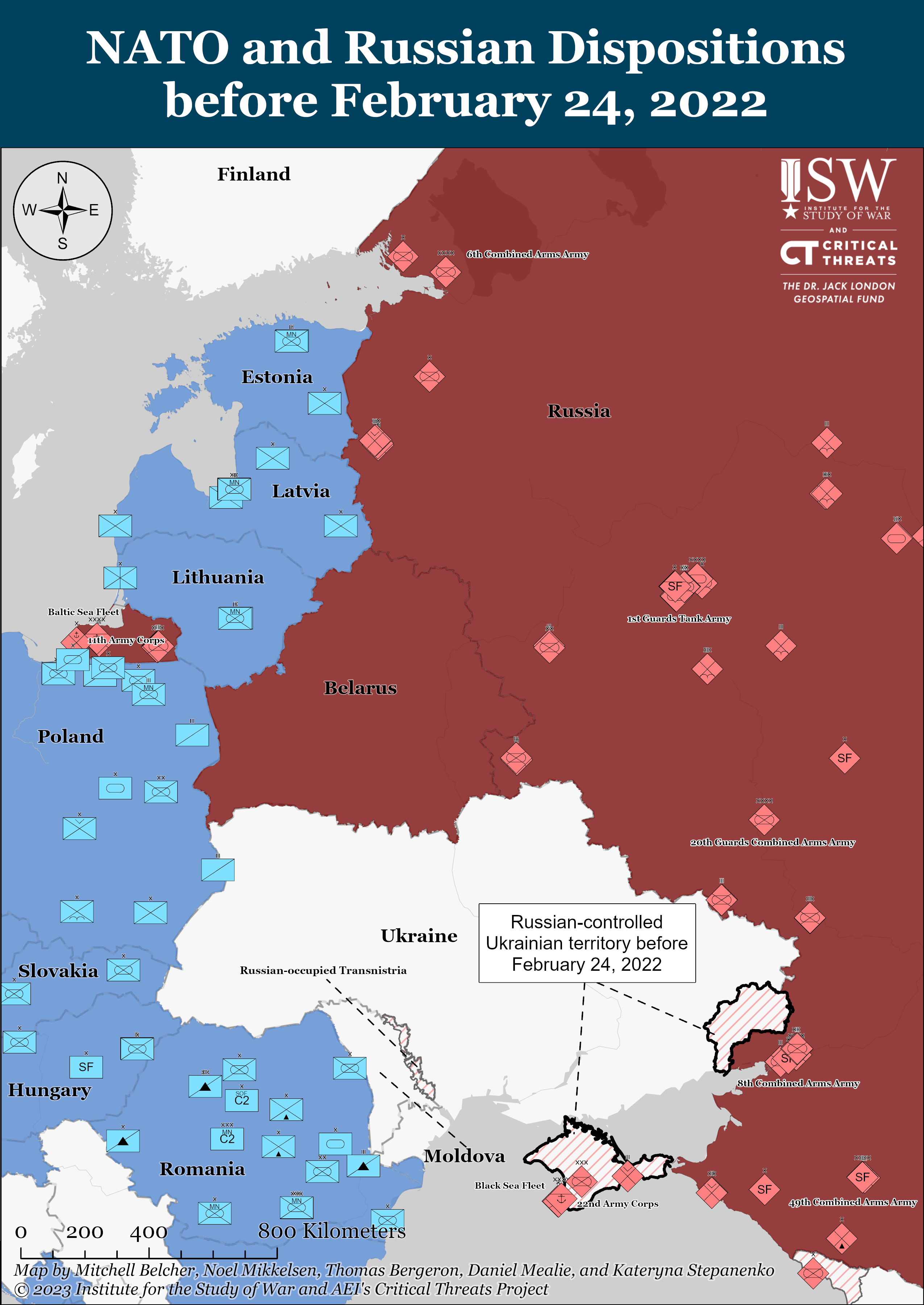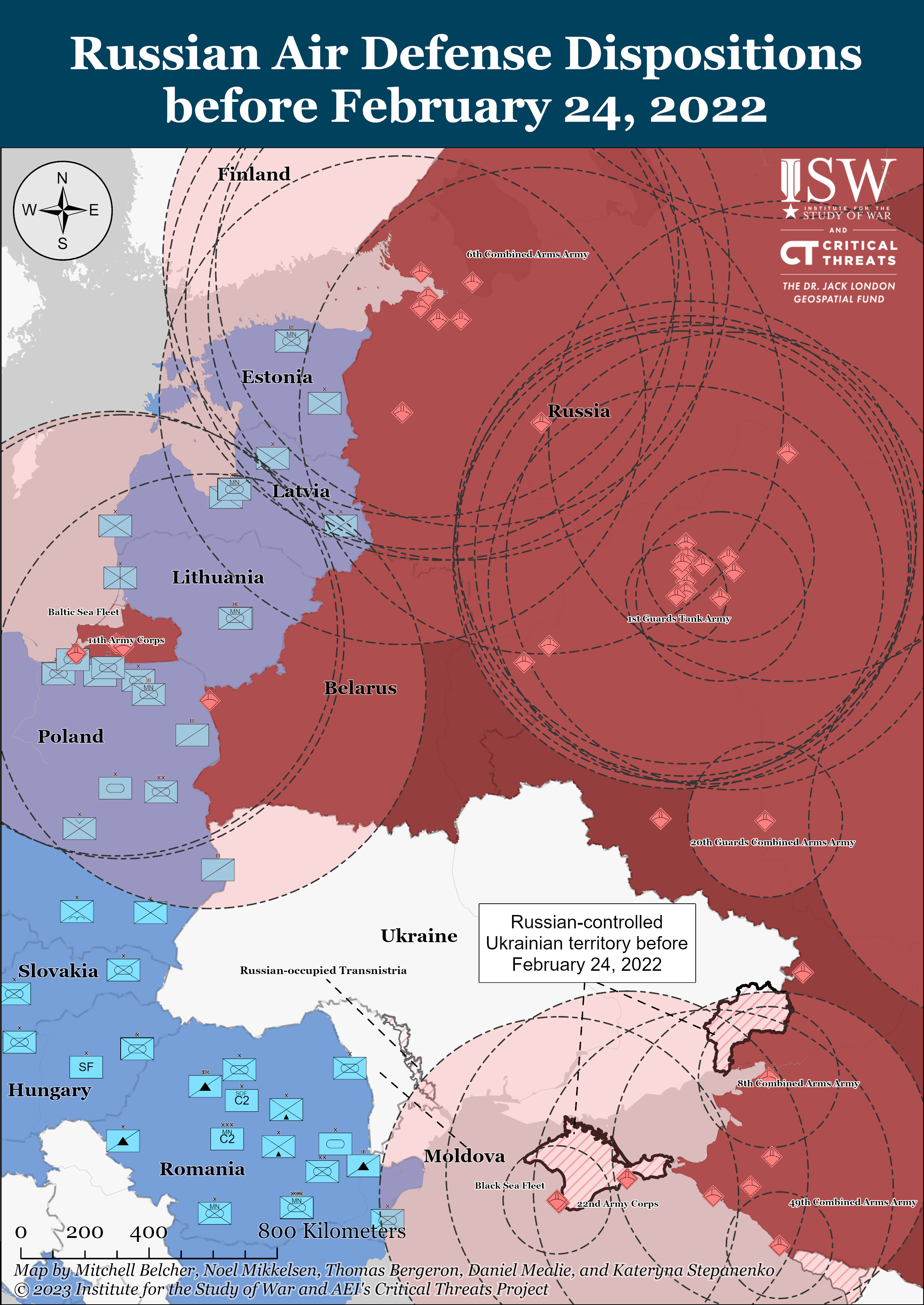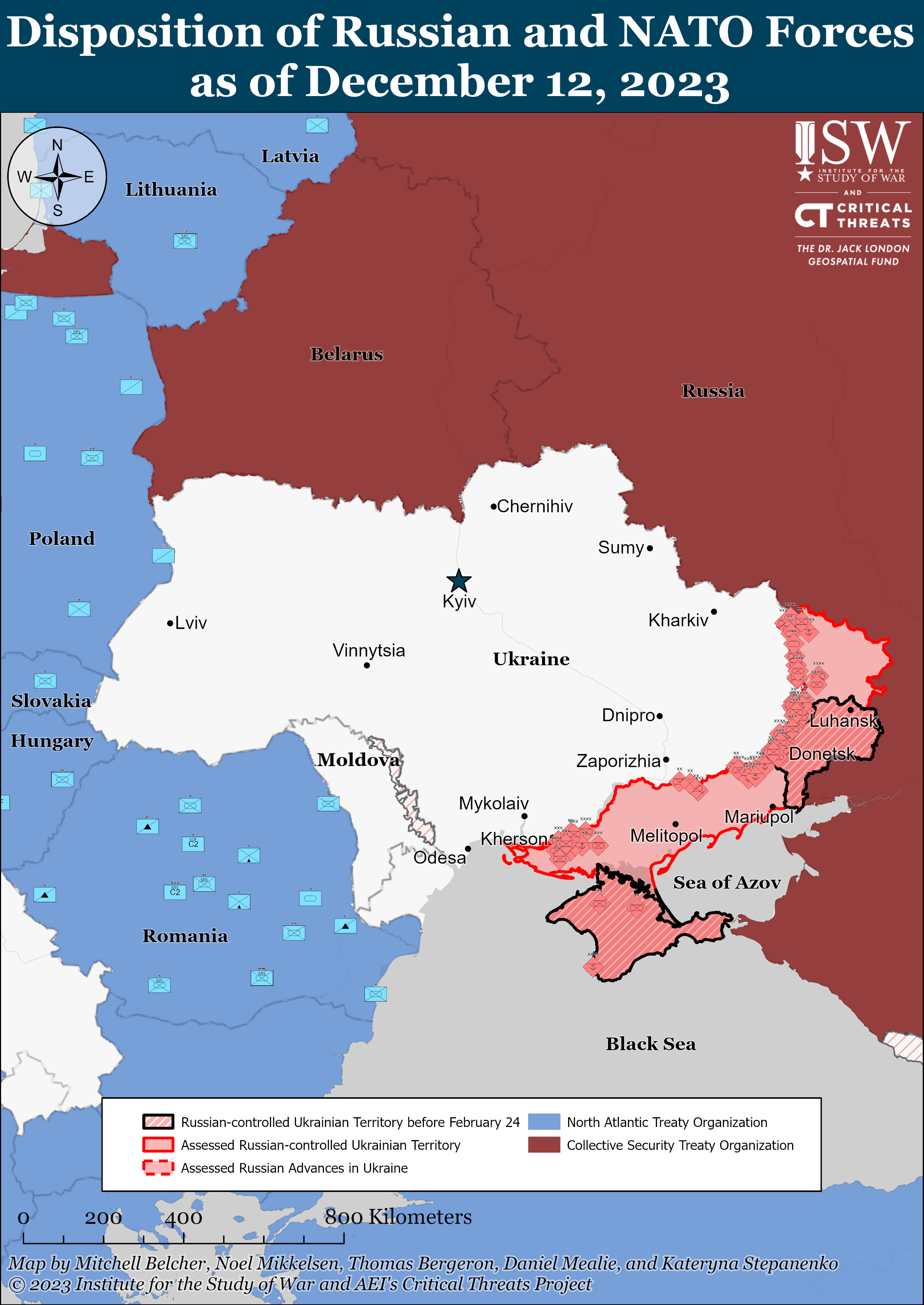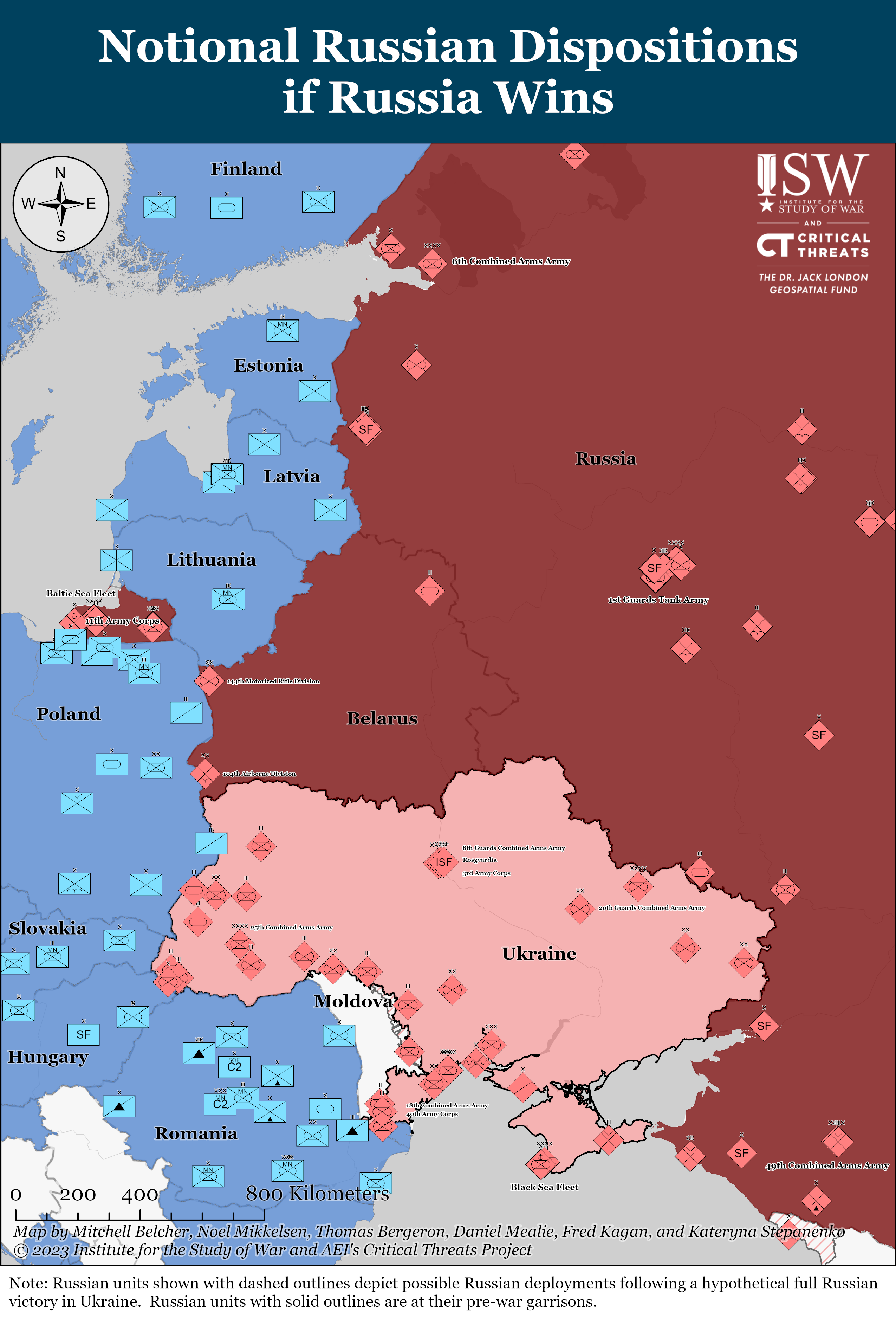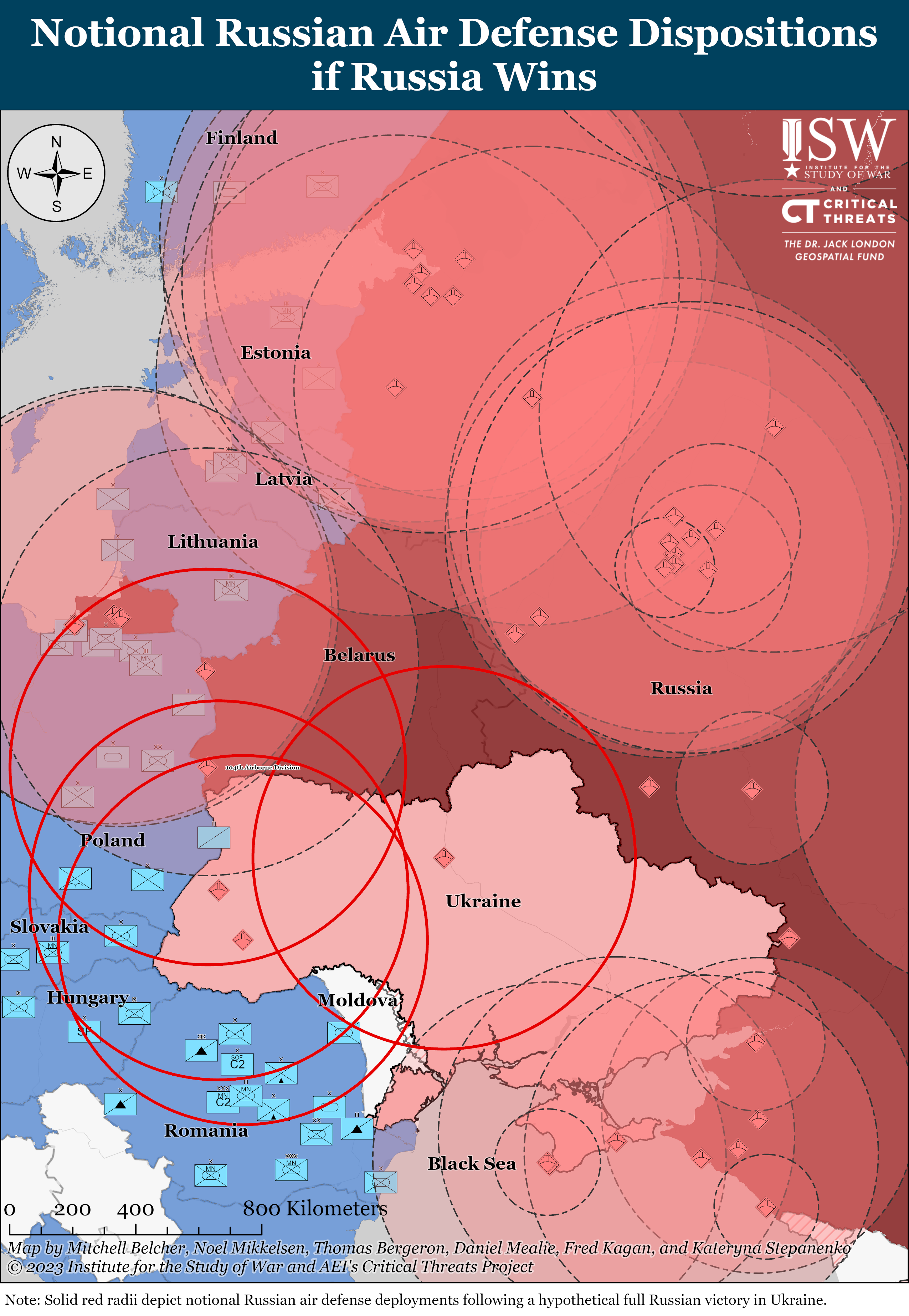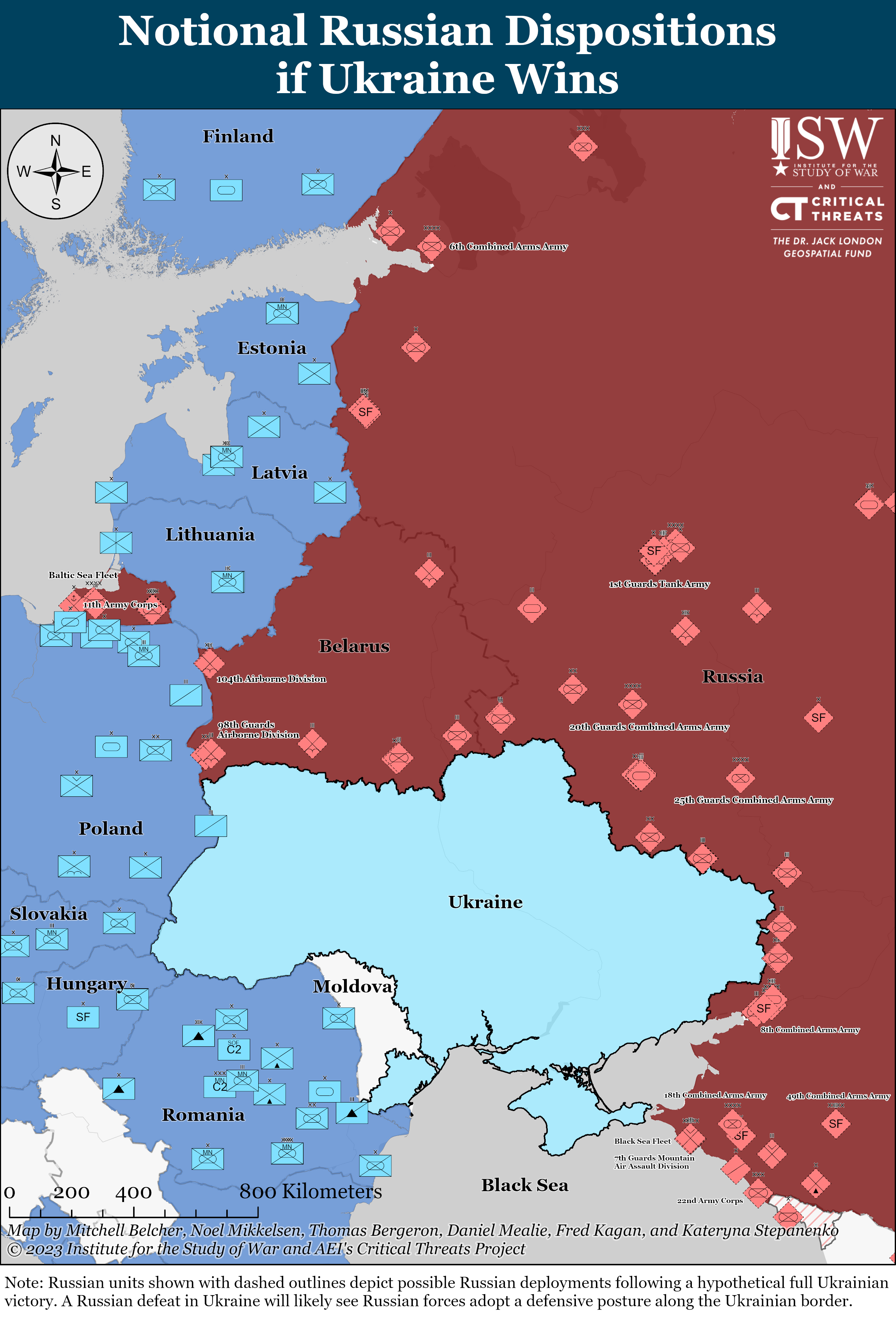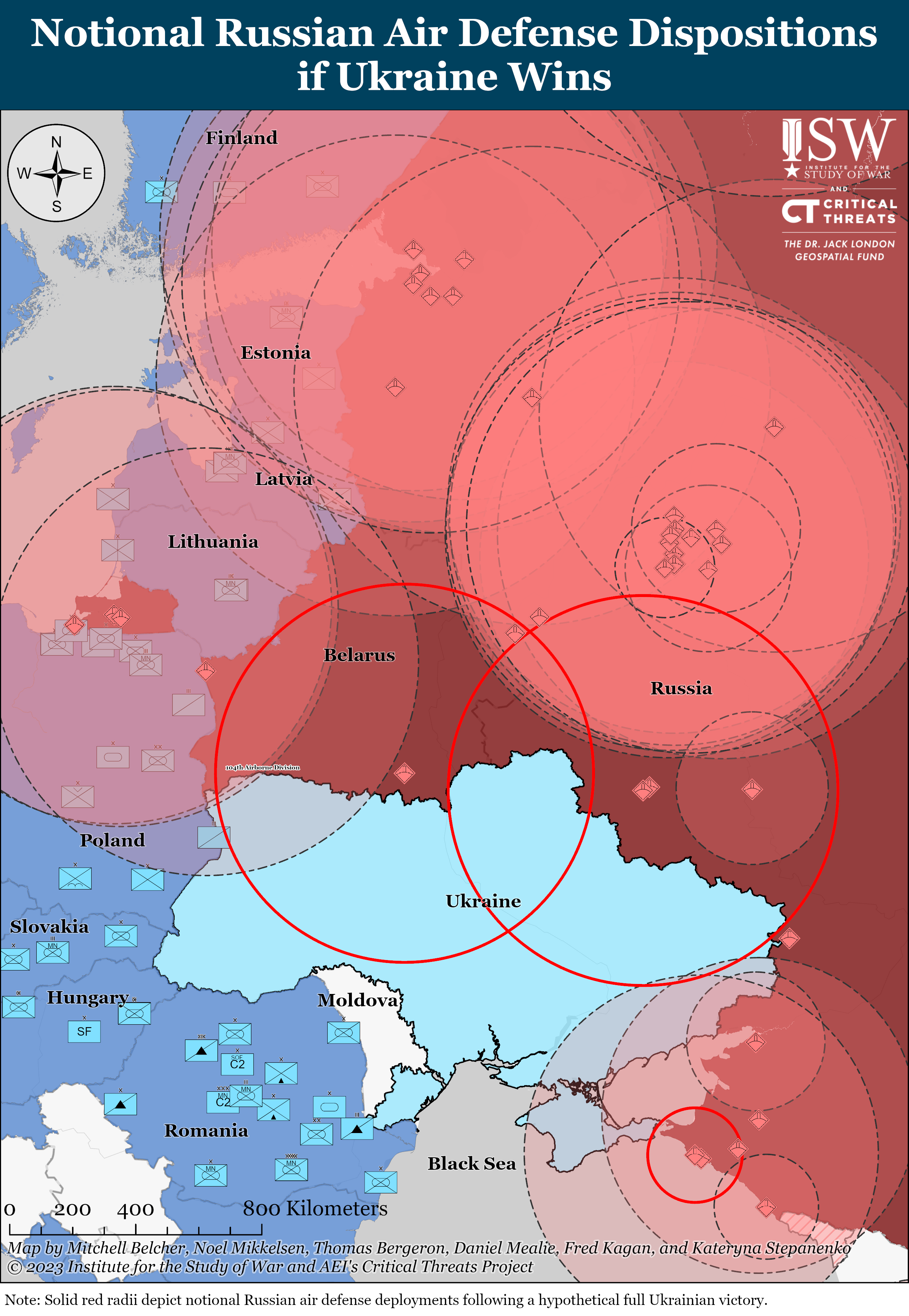SOURCE:
( ) IRAN UPDATE, DECEMBER 15, 2023: https://www.understandingwar.org/backgrounder/iran-update-december-15-2023
IRAN UPDATE, DECEMBER 15, 2023
Brian Carter, Ashka Jhaveri, Nicholas Carl, Johanna Moore,
Peter Mills, Amin Soltani, Alexandra Braverman, and Kathryn Tyson
Information Cutoff: 2:00 pm EST
The Iran Update provides insights into Iranian and Iranian-sponsored activities abroad that undermine regional stability and threaten US forces and interests. It also covers events and trends that affect the stability and decision-making of the Iranian regime. The Critical Threats Project (CTP) at the American Enterprise Institute and the Institute for the Study of War (ISW) provides these updates regularly based on regional events. For more on developments in Iran and the region, see our interactive map of Iran and the Middle East.
Note: CTP and ISW have refocused the update to cover the Israel-Hamas war. The new sections address developments in the Gaza Strip, the West Bank, Lebanon, and Syria, as well as noteworthy activity from Iran’s Axis of Resistance. We do not report in detail on war crimes because these activities are well-covered in Western media and do not directly affect the military operations we are assessing and forecasting. We utterly condemn violations of the laws of armed conflict and the Geneva Conventions and crimes against humanity even though we do not describe them in these reports.
Click here to see CTP and ISW’s interactive map of Israeli ground operations. This map is updated daily alongside the static maps present in this report.
Key Takeaways:
- Iran and its so-called “Axis of Resistance” are exploiting the Israel-Hamas war to demonstrate their capability to control a key maritime route and chokepoint in the Middle East.
- The Houthis have conducted almost daily drone and missile attacks against commercial vessels transiting the Bab al Mandeb since December 9.
- The Houthi attack campaign signals to the international community that the Axis of Resistance can imperil ships around the Bab al Mandeb in addition to the Strait of Hormuz.
- Israeli forces destroyed the headquarters of Hamas’ Shujaiya Battalion in the northern Gaza Strip.
- Israeli clearing operations may be disrupting Palestinian militia fighters’ ability to frequently communicate with each other.
- Iranian-backed fighters, including Lebanese Hezbollah (LH), conducted 11 cross-border attacks from southern Lebanon into northern Israel.
- US National Security Adviser Jake Sullivan told reporters in Tel Aviv that Israel will transition to the next phase of the war, which will focus on targeting leadership and intelligence operations rather than high-intensity clearance operations.
- The Islamic Resistance in Iraq—a coalition of Iranian-backed Iraqi militias—claimed responsibility for a one-way drone attack targeting US forces in Iraq.
- Harakat Hezbollah al Nujaba Secretary General Akram al Kaabi released a statement justifying resistance against the United States in Iraq.

Iran and its so-called “Axis of Resistance” are exploiting the Israel-Hamas war to demonstrate their capability to control a key maritime route and chokepoint in the Middle East. The Houthis have conducted almost daily drone and missile attacks against commercial vessels transiting the Bab al Mandeb since December 9. The most recent attacks occurred on December 15, when the Houthis struck two vessels off the coast of Yemen.[1] The Houthi military spokesperson framed these attacks as part of their ongoing attack campaign targeting all commercial maritime traffic headed to or affiliated with Israel and vowed to continue these attacks.[2]
The Houthi attack campaign signals to the international community that the Axis of Resistance can imperil ships around the Bab al Mandeb in addition to the Strait of Hormuz. Tehran has long worked to establish the military capabilities and posture necessary to disrupt traffic around these strategic chokepoints. US officials and Western media have reported that the Islamic Revolutionary Guards Corps (IRGC) is directly involved in planning and executing the attacks with the Houthis.[3] The IRGC similarly threatens international shipping around the Strait of Hormuz to impose pressure on foreign adversaries.[4] The IRGC, for instance, conducted an attack campaign around the Strait of Hormuz in 2019 that is similar to the one that the Houthis are now waging.[5]
These attacks are disrupting all traffic in the Red Sea, not just traffic bound for Israel. Several of the vessels that the Houthis have attacked were headed to destinations other than Israel, demonstrating the threat that the Houthis pose to global shipping more broadly.[6] Major international shipping companies, such as Maersk and Hapag-Lloyd, have responded to the Houthi attacks by pausing their operations through the Red Sea and routing ships instead around Africa.[7] Maersk alone accounts for roughly 17 percent of global shipping.[8] Other companies are reportedly scaling back their operations in the Red Sea as well.[9]
Gaza Strip
Axis of Resistance campaign objectives:
- Erode the will of the Israeli political establishment and public to launch and sustain a major ground operation into the Gaza Strip
- Degrade IDF material and morale around the Gaza Strip.
Israeli forces destroyed the headquarters of Hamas’ Shujaiya Battalion in the northern Gaza Strip. Israeli air, artillery, and engineering forces took over the compound in Shujaiya after ground forces clashed with Palestinian militia fighters.[10] Palestinian fighters in a tunnel shaft attempted to detonate an improvised explosive device targeting Israeli forces in Shujaiya.[11] The IDF responded by destroying the tunnel.[12] The al Qassem Brigades—the militant wing of Hamas—and the al Quds Brigades—the militant wing of Palestinian Islamic Jihad (PIJ)—did not claim any attacks on Israeli forces in the Shujaiya neighborhood on December 15. CTP-ISW previously reported that Hamas’ Shujaiya Battalion remains capable of executing its defense mission in Shujaiya, indicating that it is not combat ineffective.[13] This is despite several Israeli military sources reporting that Hamas’ Shujaiya Battalion is “dismantled” and lost its “command and control” capabilities.[14] IDF Chief of Staff Herzi Halevi told Israeli forces in the Gaza Strip on December 14 that they are facing challenging terrain in the Shujaiya and Zaytoun neighborhoods.[15] An Israeli journalist embedded with the IDF’s Kfir Brigade in Shujaiya reported on December 11 that Hamas forces in Shujaiya are ”waging a guerrilla war” and have not ”abandoned the fight.[16]
Israeli clearing operations may be disrupting Palestinian militia fighters' ability to frequently communicate with each other. The disruption of Palestinian fighters’ communications would make it more difficult for fighters to transmit reports to the media officials responsible for generating attack claims. This disruption may be contributing to the lower rate of attack claims in Shujaiya, for example. Residents told Reuters on December 15 that there is intense fighting across the northern Gaza Strip, including Shujaiya, Zaytoun, and Tuffah where Israeli forces are attempting to dismantle the Shujaiya Battalion.[17] The al Quds Brigades posted on its Telegram channel on December 15 that it had resumed contact with its forces east of Gaza City.[18] The ground forces relayed their various attack claims. The al Qassem Brigades have similarly posted several times in the past week that its forces relayed their various kinetic engagements after returning from the front lines in the northern Gaza Strip.[19] CTP-ISW did not observe the militias using language that suggests that there is a significant strain on communication networks at any other point in the war.
The residents also reported fighting in Sheikh Radwan neighborhood, southwest of Jabalia city where Israeli forces have been operating since November 18.[20] The al Quds Brigades claimed that its fighters targeted three military vehicles with tandem shells in Beit Lahiya, northwest of Jabalia city.[21] The Abu Ali Mustafa Brigades claimed two clashes with Israeli forces in the Jabalia refugee camp and Sheikh Radwan neighborhood, southwest of Jabalia city.[22]
Israeli forces mistakenly identified three Israeli hostages held in the Gaza Strip as a threat and killed them during clearing operations in the Shujaiya neighborhood of Gaza city. The IDF confirmed the incident and the identities of the hostages on December 15.[23] The Israelis were taken hostage during Hamas’ October 7 attack.[24]
Palestinian militia fighters attempted to lure Israeli forces into a tunnel using simulated sounds of children.[25] The IDF reported on December 15 that its forces encountered a tactically sophisticated Hamas ambush involving a speaker system set up outside a tunnel system that runs through civilian infrastructure, including a school, clinic, and mosque.[26] Israeli forces identified anti-tank positions and a minefield during the operation.[27] The ambush demonstrates that Hamas retains a degree of tactical effectiveness that allows its fighters to undertake complex tactical tasks.
Palestinian militias continued attacks on Israeli forces behind the Israeli forward line of advance in the northern Gaza Strip, which is consistent with the nature of clearing operations. The al Qassem Brigades claimed that its fighters clashed with Israeli forces inside an Israeli combat outpost in the Juhor ad Dik area.[28] The militia separately claimed that it fired a thermobaric rocket at an Israeli-held building in Juhor ad Dik.[29] Israeli forces crossed into the central Gaza Strip from near Juhor ad Dik at the beginning of the ground operation.[30] Palestinian militia fighters have claimed several indirect fire attacks on Israeli forces south of Gaza City, which suggests that they are attempting to harass and disrupt the Israeli ground lines of communication that support offensive operations in the northern Gaza Strip.
Palestinian militias continued to resist Israeli advances in the southern Gaza Strip on December 15. Al Qassem Brigades fighters detonated a house-borne improvised explosive device targeting Israeli forces east of Khan Younis on December 15.[31] The al Quds Brigades also posted videos showing its forces mortaring Israeli units east of Khan Younis.[32]
Palestinian media reported that Palestinian militias engaged Israeli forces with small arms east of Rafah on December 15.[33] CTP-ISW has not previously observed ground clashes in eastern Rafah after Israeli forces entered the southern Gaza Strip.
Israeli forces targeted Hamas military infrastructure in Khan Younis and Rafah as part of Israeli efforts to degrade Hamas’ military capacity. IDF special operations forces and ground forces units continued raids and clearing operations in the southern Gaza Strip.[34] The IDF said that it discovered tunnel shafts in Khan Younis, including one tunnel shaft with motorcycles inside that the IDF said Hamas used in the October 7 attacks.[35] An IDF raid also targeted the home of Hamas’ North Khan Younis Battalion rocket artillery commander.[36] The IDF reported that it killed the North Khan Younis Battalion commander on October 27.[37] Hamas‘ formal military structure means that it will likely rapidly replace the rocket artillery commander with his deputy, ensuring continuity of command and rapid reconstitution of Hamas‘ military forces.[38]
Israeli forces conducted airstrikes targeting Hamas military infrastructure near the Egyptian-Gaza Strip border in Rafah governorate. The airstrikes targeted buildings and other areas that the IDF said Hamas uses for smuggling weapons.[39] Hamas has historically used a system of tunnels to smuggle weapons into the Strip, rather than formal border crossings.[40]
US National Security Adviser Jake Sullivan told reporters in Tel Aviv that Israel will transition to the next phase of the war, which will focus on targeting leadership and intelligence operations rather than high-intensity clearance operations.[41] Sullivan was in Israel to meet with a number of Israeli officials, including Israeli Prime Minister Benjamin Netanyahu and Defense Minister Yoav Gallant.[42] Sullivan declined to specify a time frame for the end of high-intensity clearing operations to avoid “telegraph[ing] for the enemy what the plan is.”[43] A senior administration official said on background in a White House press briefing that ”reporting on timeframes” for the phases of the war was ”not entirely accurate.”[44] The New York Times cited four US officials on December 14 who claimed that Biden wanted the war to shift to a more targeted, narrow campaign in about three weeks.[45]
Palestinian militias conducted six indirect fire attacks from the Gaza Strip into Israel on December 15.[46] The al Qassem Brigades fired a barrage of long-range rockets at Jerusalem for the first time since October 22.[47] The al Quds Brigades claimed that it fired rockets at Jerusalem on December 1.[48] The al Quds Brigades claimed three rocket attacks into southern Israel on December 15 including at an Israeli military site.[49][50]
Recorded reports of rocket attacks; CTP-ISW cannot independently verify impact.
Recorded reports of rocket attacks; CTP-ISW cannot independently verify impact.
West Bank
Axis of Resistance campaign objectives:
- Draw IDF assets and resources toward the West Bank and fix them there
Palestinian fighters clashed with Israeli forces three times in the West Bank on December 15.[51] This rate of activity is less than the daily average of 9.7 attacks per day. The Jenin Battalion of the al Quds Brigades claimed that it conducted an attack using small arms fire and explosives on Israeli forces at a checkpoint to Mevo Dotan.[52] The militia fighters also claimed that they placed an anti-personnel explosive device in an Israeli military vehicle and then detonated it.[53] This is the first time that the al Quds Brigades has claimed such an attack since the Israel-Hamas war began.
Hamas in the West Bank successfully organized protests in Nablus on December 15. Hamas distributed a flyer on December 14 calling for Palestinians in Nablus to protest after Friday prayers in support of Palestinians in the Gaza Strip.[54] Palestinian sources published footage of marches in Nablus with Hamas flags and posters of Hamas fighters who had died since the start of the Israel-Hamas war.[55]
This map is not an exhaustive depiction of clashes and demonstrations in the West Bank.
Southern Lebanon and Golan Heights
Axis of Resistance campaign objectives:
- Draw IDF assets and resources toward northern Israel and fix them there
- Set conditions for successive campaigns into northern Israel
Iranian-backed fighters, including Lebanese Hezbollah (LH), conducted 11 cross-border attacks from southern Lebanon into northern Israel on December 15.[56] LH targeted Israeli military sites in northern Israel eight times, including two attacks using Burkan rockets.[57] The warheads for Burkan rockets range from 300 to 500 kilograms, making them a more lethal weapon system than the smaller rockets LH typically employs.[58] LH separately fired rockets and mortars at the IDF’s Ramim barracks in northern Israel.[59] The IDF said it intercepted a drone from southern Lebanon over Israeli airspace.[60] A second drone fell near an IDF post.[61]
LH published a summary of its attacks into Israel since the start of the Israel-Hamas war.[62] LH claimed that it has conducted over 500 operations in over 50 locations in northern Israel since October 8. LH’s attack claim is mostly consistent with CTP-ISW's documentation of approximately 440 total attacks since October 8.
Iran and Axis of Resistance
Axis of Resistance campaign objectives:
- Demonstrate the capability and willingness of Iran and the Axis of Resistance to escalate against the United States and Israel on multiple fronts
- Set conditions to fight a regional war on multiple fronts
The Islamic Resistance in Iraq—a coalition of Iranian-backed Iraqi militias—claimed responsibility for a one-way drone attack targeting US forces in Iraq on December 15. The Islamic Resistance in Iraq said that it targeted US forces at Ain al Assad airbase with a one-way drone.[63]
Popular Mobilization Force (PMF) Chairman Faleh al Fayyadh met with interim Ninewa Governor Abdul Qadir al Dakhil on December 15 to discuss improving security in the province for the upcoming provincial elections.[64] Dakhil worked as head of the Supreme Council for the Reconstruction of Mosul. Kataib Hezbollah members also escorted Dakhil in Ninewa Province after Dakhil was appointed as acting governor.[65] Fayyadh and Dakhil’s meeting is notable in the context of other Iranian-backed proxy activity in Ninewa. The Kataib Hezbollah-affiliated 47th Brigade’s 2nd Regiment deployed to Sinjar, Ninewa province on December 14.[66] This regiment is reinforcing other 47th Brigade units that were ostensibly providing security for voting centers during the provincial elections. The Soufan Center reports that Iranian-backed militias intimidated voters during the 2021 federal elections.[67] Ninewa province locals warned that the militias prevented political opposition from registering to run for provincial elections.[68]
Harakat Hezbollah al Nujaba (HHN) Secretary General Akram al Kaabi released a statement justifying resistance against the United States in Iraq following the arrest of unspecified individuals tied to the December 8 attack on the US Embassy in Baghdad.[69] Spokesperson for the Iraqi Commander in Chief of the Armed Forces Major General Yahya Rasool announced on December 14 that Iraqi security forces arrested individuals connected to the rocket and mortar attacks targeting the US Embassy.[70] US Ambassador to Iraq Alina Romanowski thanked Iraqi Prime Minister Mohammed Shia al Sudani for arresting the individuals “responsible for the terrorist attacks” on the embassy.[71] Kaabi claimed that the United States stole resources and interfered in Iraq’s internal affairs and argued that he was justified and “expressing popular will” by conducting attacks on the United States.[72] He declared that if this made him a terrorist, then “let the world witness that I am a terrorist.” Kaabi is a Specially Designated Global Terrorist by the US Department of the Treasury.[73]
The Balochi Salafi-jihadi group Jaish al Adl conducted a two-stage attack targeting a police station in Rask, Sistan and Baluchistan Province on December 15.[74] The Jaish al Adl fighters raided the police station, which prompted Iran’s Law Enforcement Command to dispatch a quick reaction force (QRF). The fighters then laid an ambush targeting the QRF. The two-stage attack killed at least 11 LEC officers and injured eight more. The LEC killed two Jaish al Adl fighters during the attack. Jaish al Adl conducted a similar attack on a police station in Zahedan, Sistan and Baluchistan Province on July 8 that killed two LEC officers.[75] Jaish al Adl said after the July 8 attack that civil disobedience is insufficient to secure Balochi rights and it vowed to conduct more ”targeted and harmful” attacks in the future. Jaish al Adl issued threats against the regime in October 2022 following security forces’ violent suppression of protesters in Zahedan on September 30, 2022, an event that became known as “Bloody Friday.”[76]
The Iranian deputy foreign affairs minister discussed the Israel-Hamas war with his Chinese and Saudi counterparts in Beijing on December 15.[77] The deputy foreign affairs ministers of all three countries emphasized the need for an immediate ceasefire in the Gaza Strip and an independent Palestinian state. The overall purpose of the meeting was to discuss recent progress in the Chinese-mediated normalization of relations between Iran and Saudi Arabia.
Iranian Parliament Speaker Mohammad Bagher Ghalibaf spoke on the phone with Algerian Assembly President Ibrahim Boughali about the Israel-Hamas war on December 15.[78] Ghalibaf reiterated his desire to hold a meeting of the Permanent Committee on Palestine to examine practical solutions for the Palestinian people.


[1] https://www.reuters.com/world/middle-east/uk-maritime-agency-probing-rep...
[2] https://twitter.com/army21ye/status/1735654693651505290
[3] https://www.cnn.com/2021/08/06/politics/us-monitor-iran-spy-ships/index.... ; https://www.reuters.com/world/middle-east/iran-involved-planning-executi...
[4] https://www.aei.org/research-products/report/pivot-to-offense-how-iran-i...
[5] https://www.aei.org/research-products/report/attribution-intent-and-resp...
[6] https://maritime-executive.com/article/hapag-and-msc-containerships-atta...
[7] https://www.bbc.com/news/world-middle-east-67731853; https://www.cnbc.c...
[8] https://www.reuters.com/business/maersk-posts-q2-profits-above-forecast-...
[9] https://www.ft.com/content/3f5d2519-94cb-4f37-9049-4e0e936212e2
[10] https://twitter.com/idfonline/status/1735562483400618421; https://twitter.com/AvichayAdraee/status/1735564537561067675
[11] https://twitter.com/idfonline/status/1735562483400618421; https://twitter.com/AvichayAdraee/status/1735564537561067675
[12] https://twitter.com/idfonline/status/1735562483400618421
[13] https://www.understandingwar.org/backgrounder/iran-update-december-13-2023
[14] https://twitter.com/Doron_Kadosh/status/1734872801314546125; https://www.timesofisrael.com/ten-soldiers-including-two-senior-officers... https://twitter.com/manniefabian/status/1734264932714058134
[15] https://twitter.com/idfonline/status/1735351596886663458
[16] https://www.ynet dot co.il/news/article/yokra13709771
[17] https://www.reuters.com/world/middle-east/us-stresses-safety-gaza-civili...
[18] https://t.me/sarayaps/16947
[19] https://t.me/qassambrigades/29526; https://t.me/qassambrigades/29523; ... https://t.me/qassambrigades/29494
[20] https://twitter.com/IDFSpokesperson/status/1725887408934154628; https://www.reuters.com/world/middle-east/us-stresses-safety-gaza-civili...
[21] https://t.me/sarayaps/16941
[22] https://t.me/kataebabuali/10542; https://t.me/kataebabuali/10543
[23] https://twitter.com/IDFSpokesperson/status/1735725832377688475; https://twitter.com/IDFSpokesperson/status/1735725834235732332
[24] https://twitter.com/IDFSpokesperson/status/1735725834235732332
[25] https://twitter.com/idfonline/status/1735630862186594541
[26] https://twitter.com/idfonline/status/1735630872215224506
[27] https://twitter.com/idfonline/status/1735630872215224506
[28] https://t.me/qassam1brigades/854
[29] https://t.me/qassam1brigades/856
[30] https://t.me/qassam1brigades/281 ; https://t.me/qassam1brigades/285 ; https://t.me/AymanGouda/5830
[31] https://t.me/qassam1brigades/857
[32] https://t.me/sarayaps/16944
[33] https://t.me/QudsN/344233
[34] https://www.idf dot il/162485
[35] https://x.com/GLZRadio/status/1735560388538736681?s=20
[36] https://www.idf dot il/162485
[37] https://twitter.com/idfonline/status/1717826689076531446
[38] https://www.criticalthreats.org/analysis/the-order-of-battle-of-hamas-iz...
[39] https://www.idf dot il/162360
[40] https://www.cnn.com/2023/10/11/middleeast/hamas-weaponry-gaza-israel-pal...
[41] https://www.reuters.com/world/middle-east/us-stresses-safety-gaza-civili...
[42] https://www.nytimes.com/2023/12/15/world/middleeast/jake-sullivan-will-m... https://www.whitehouse.gov/briefing-room/press-briefings/2023/12/14/back...
[43] https://www.nytimes.com/2023/12/15/world/middleeast/jake-sullivan-will-m...
[44] https://www.whitehouse.gov/briefing-room/press-briefings/2023/12/14/back...
[45] https://www.nytimes.com/2023/12/14/us/politics/israel-gaza-hamas-us.html
[46] https://t.me/qassam1brigades/852; https://t.me/qassam1brigades/858; https://t.me/sarayaps/16945;
https://t.me/sarayaps/16948; https://t.me/qassam1brigades/859
[47] https://www.timesofisrael dot com/liveblog_entry/sirens-triggered-in-jerusalem-following-long-range-rocket-fire-from-gaza/; https://t.me/qassam1brigades/859; https://t.me/qassambrigades/28695
[48] https://t.me/sarayaps/16766
[50] https://t.me/sarayaps/16948; https://t.me/sarayaps/16945
[51] https://t.me/QudsN/344347 ; https://t.me/almanarnews/140027 ; https://t.me/QudsN/344398
[52] https://t.me/almanarnews/140027
[53] https://t.me/almanarnews/140027
[54] https://t.me/hamaswestbank/48940
[55] https://t.me/QudsN/344360 ; https://t.me/QudsN/344372
[56] https://t.me/C_Military1/41730; https://t.me/C_Military1/41732; https://t.me/C_Military1/41739; https://t.me/C_Military1/41744; https://t.me/C_Military1/41744; https://t.me/C_Military1/41747; https://t.me/C_Military1/41756; https://t.me/C_Military1/41758; https://twitter.com/idfonline/status/1735664251023278104; https://t.me/C_Military1/41764
[57] https://t.me/C_Military1/41730; https://t.me/C_Military1/41758
[58] https://www.reuters.com/world/middle-east/hezbollah-says-front-with-isra...
[59] https://t.me/C_Military1/41747
[60] https://twitter.com/idfonline/status/1735664251023278104
[61] https://twitter.com/idfonline/status/1735664251023278104
[62] https://central-media dot net/36920/631/; https://t.me/C_Military1/41760
[63] https://t.me/elamharbi/161
[64] https://t.me/teamsmediawar_1/95345
[65] https://www.shafaq dot com/ar/%D8%B3%DB%8C%D8%A7%D8%B3%D8%A9/%D8%A7%D9%84%D8%B3%D9%88%D8%AF%D8%A7%D9%86%D9%8A-%D9%8A%D9%83%D9%81%D9%84-%D8%B9%D8%A8%D8%AF-%D8%A7%D9%84%D9%82%D8%A7%D8%AF%D8%B1-%D8%A7%D9%84%D8%AF%D8%AE%D9%8A%D9%84-%D8%A8%D9%85%D9%87%D8%A7%D9%85-%D9%85%D8%AD%D8%A7%D9%81%D8%B8-%D9%86%D9%8A%D9%86%D9%88%D9%89-%D9%88%D8%AB%D9%8A%D9%82%D8%A9 ; https://twitter.com/antfadt/status/1730184341404151962 ; https://www.ina%20dot%20iq/125552--.html
[66] https://al-hashed.gov dot iq/?p=515941
[67] https://thesoufancenter.org/intelbrief-2021-june-7/
[68] https://apnews.com/article/middle-east-religion-iran-elections-united-st... ; https://almadapaper dot net/view.php?cat=298165
[69] https://t.me/Akram_Alkaabi/131
[70] https://www.ina dot iq/199237--.html ; https://www.ninanews dot com/Website/News/Details?key=1095313
[71] https://twitter.com/USAmbIraq/status/1735339068521635908
[72] https://t.me/Akram_Alkaabi/131
[73] https://sanctionssearch.ofac.treas.gov/Details.aspx?id=11170
[74] https://www.tasnimnews dot com/en/news/2023/12/15/3006805; https://www.iranintl dot com/202312150182; https://www.iranintl dot com/202312151934; https://www.iranintl dot com/202312152058; https://www.tasnimnews dot com/fa/news/1402/09/24/3006762 ; https://www.criticalthreats.org/analysis/iran-crisis-update-october-4 ;...
[75] https://www.nbcnews.com/news/world/iran-militants-attack-police-station-... https://www.tasnimnews dot com/en/news/2023/07/08/2922412
[76] https://www.criticalthreats.org/analysis/iran-crisis-update-october-4 ; https://www.criticalthreats.org/analysis/iran-update-july-10-2023
[77] http://www.farsnews dot ir/news/14020924000437/; https://english.alarabiya dot net/News/saudi-arabia/2023/12/15/Saudi-Arabia-Iran-committed-to-Beijing-Agreement-Statement
[78] https://www.tasnimnews dot com/en/news/2023/12/15/3006969/iranian-parliament-speaker-calls-for-urgent-meeting-on-gaza-crisis







